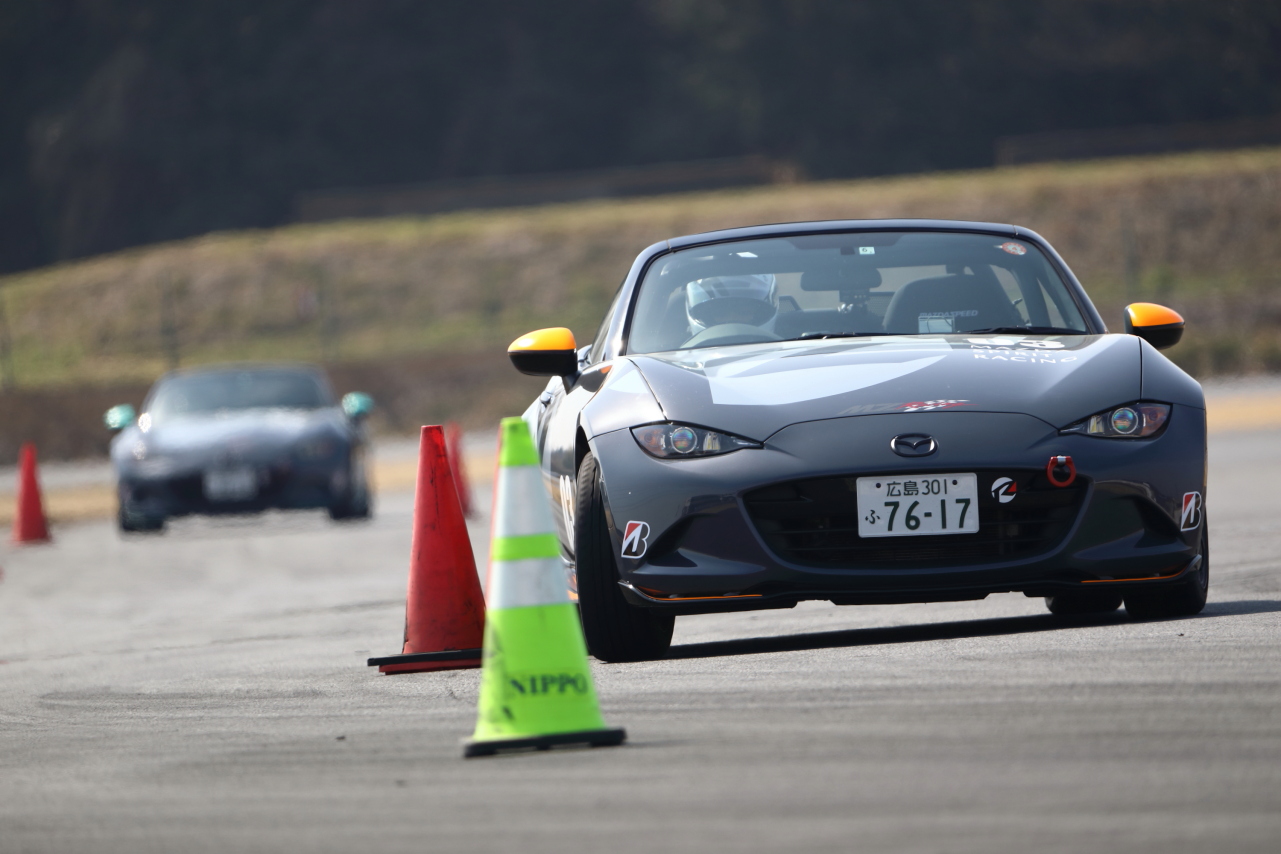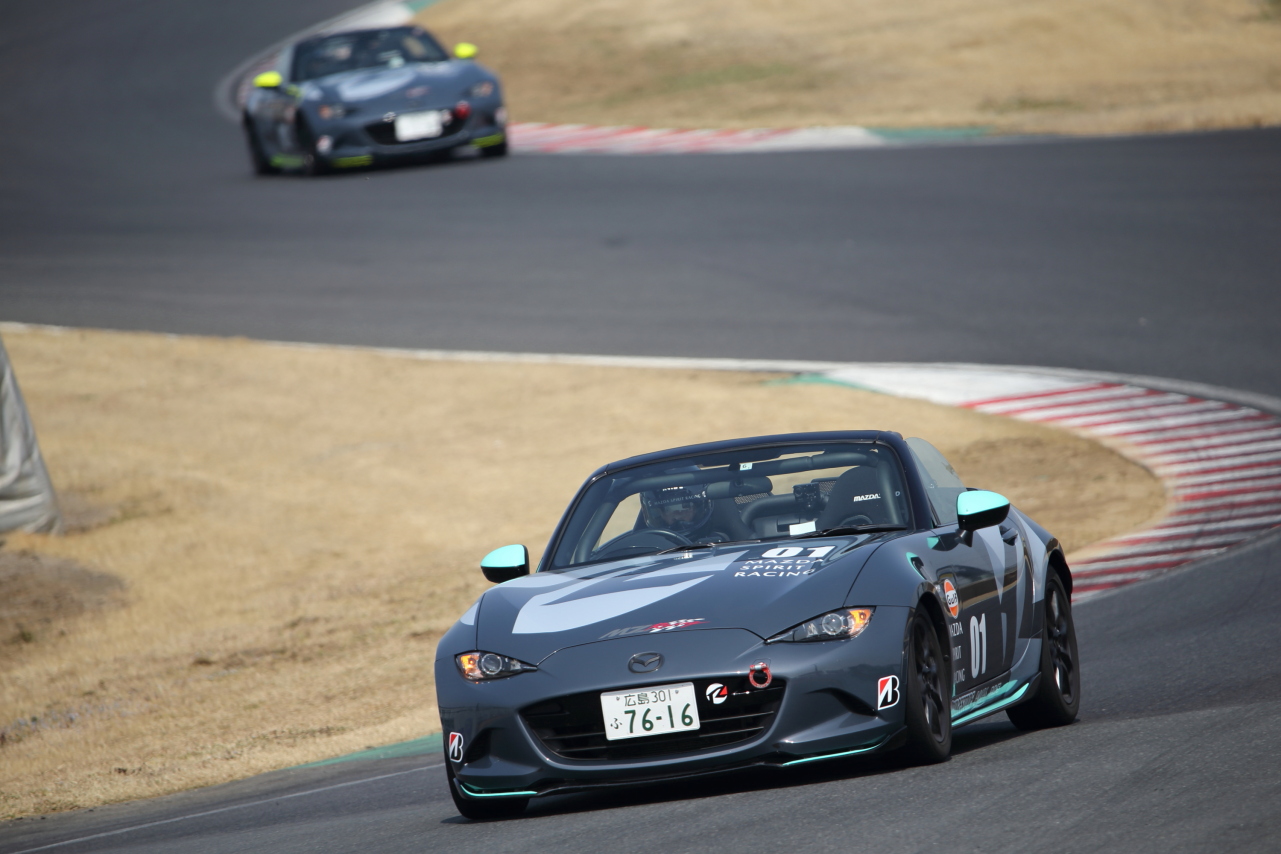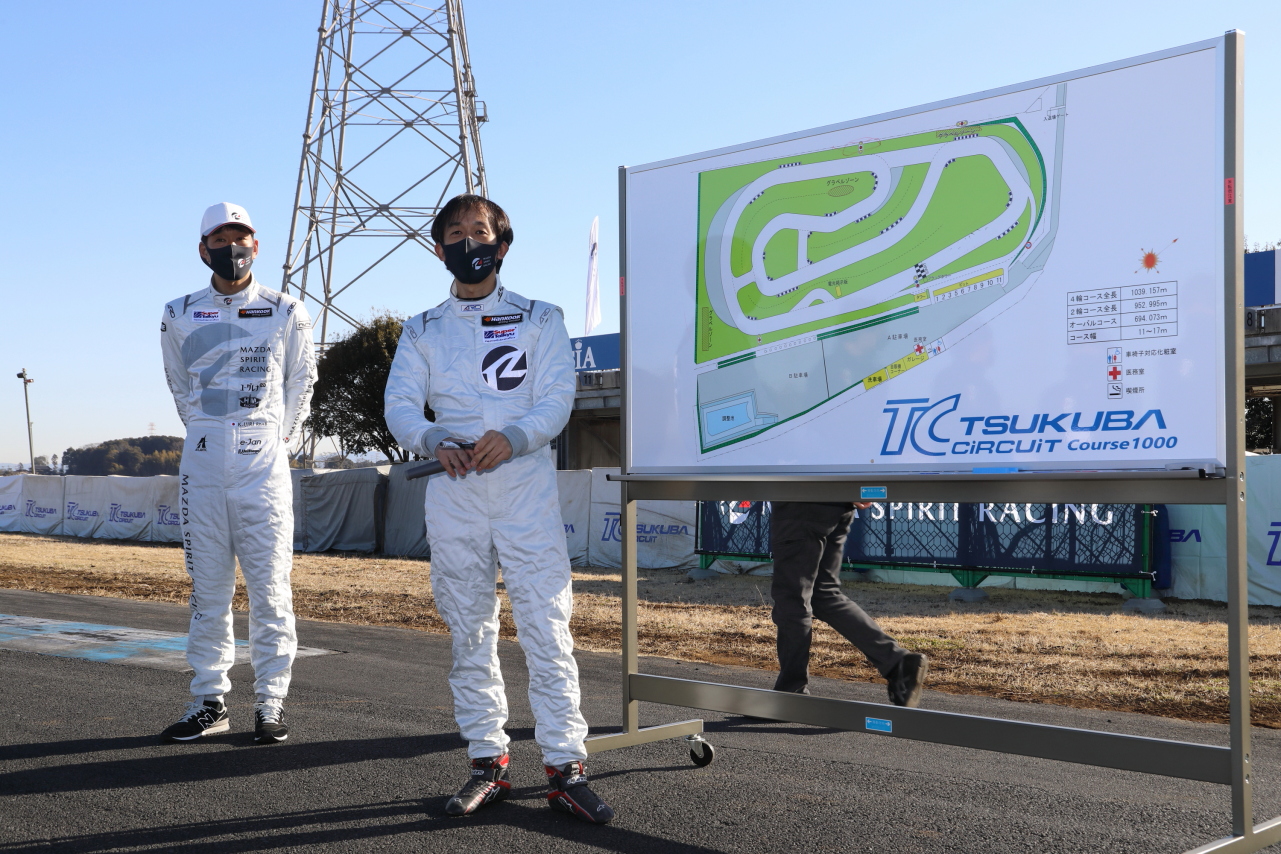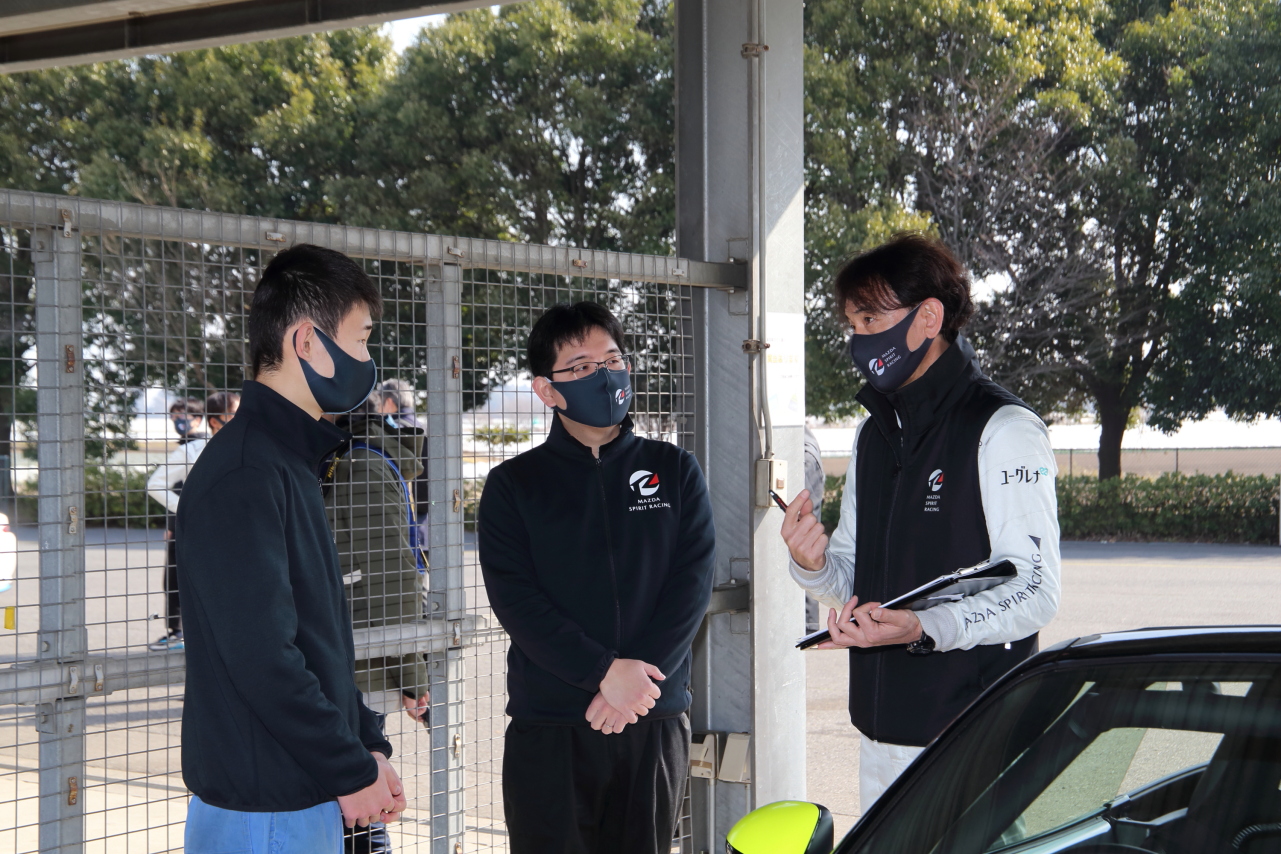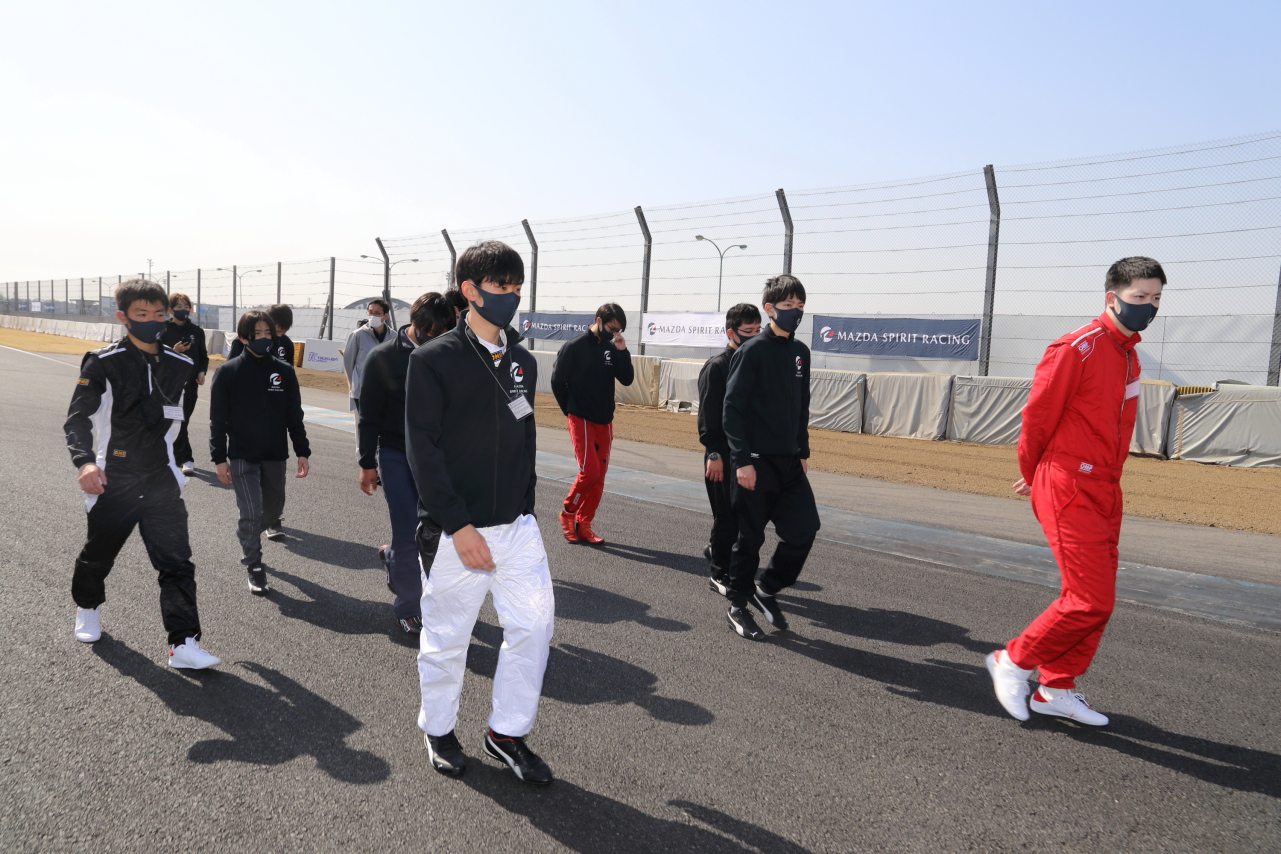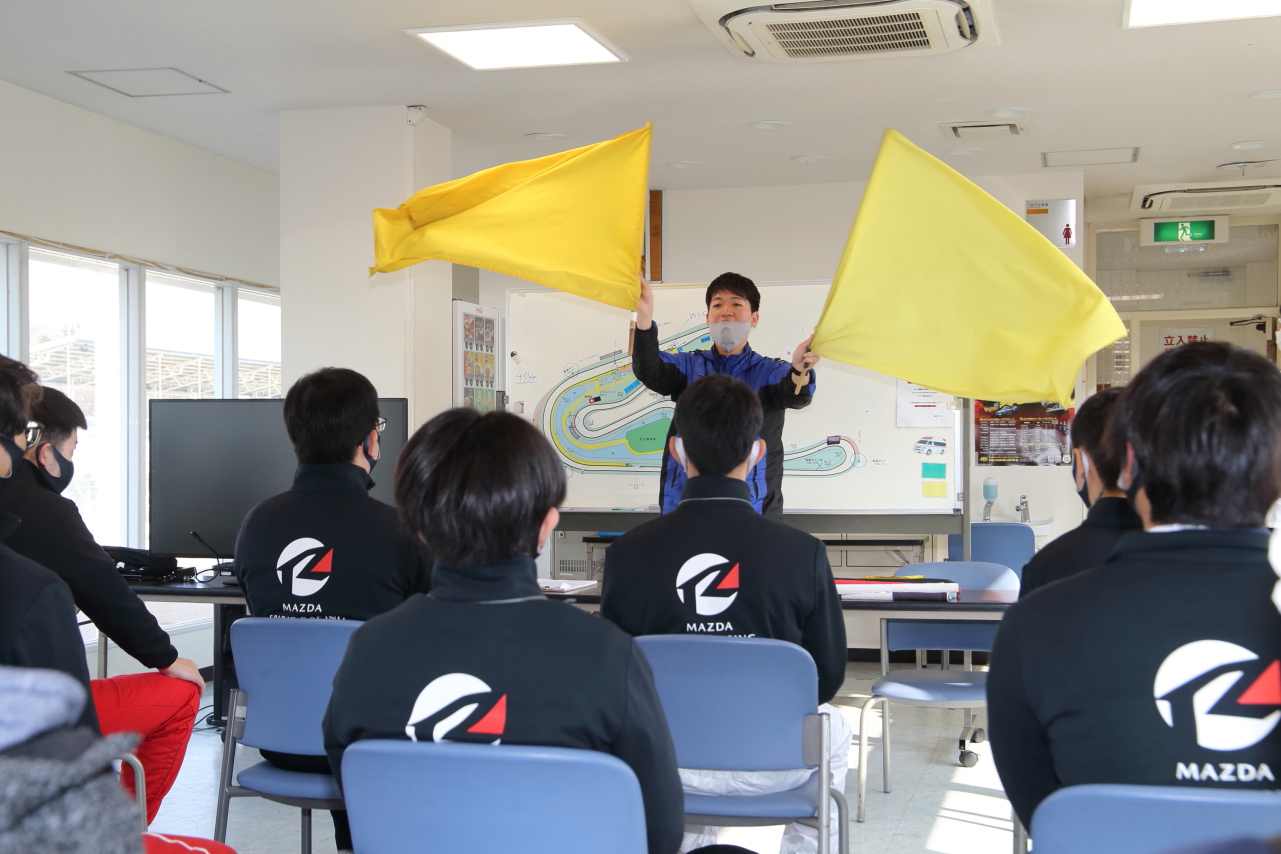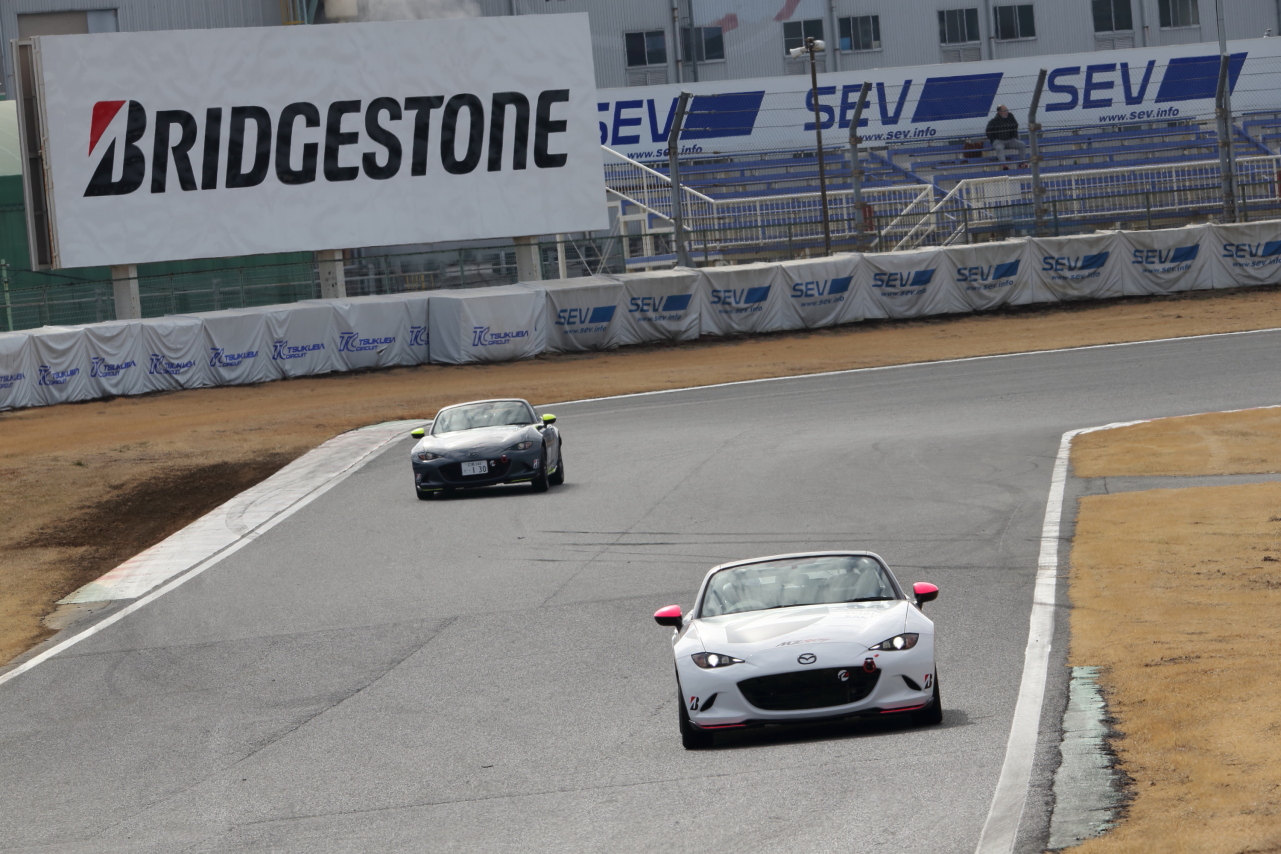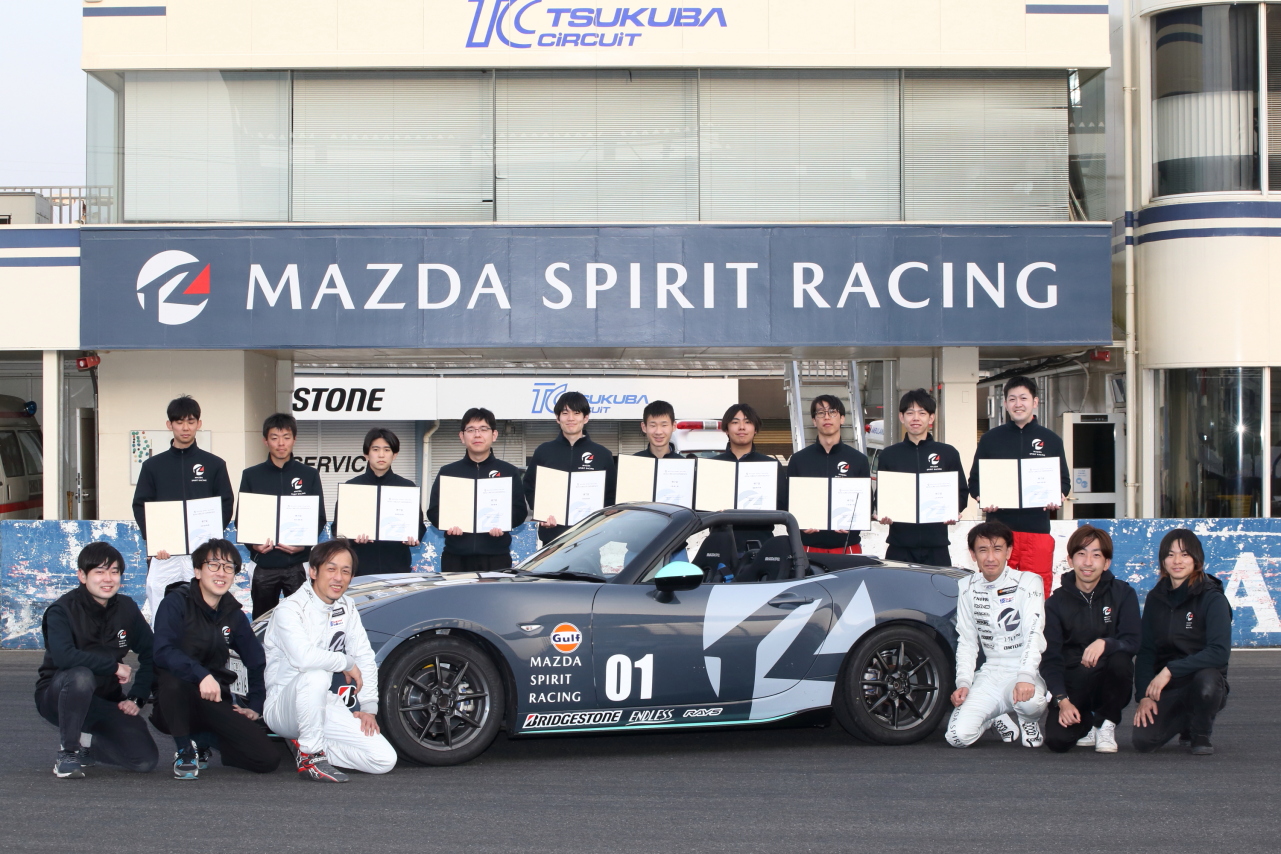- 2023/03/16
From Virtual to Real Racers: Challenge Program Underway!

Mazda is making a full-fledged return to the world of motorsports with its participation in the final round of the Super Taikyu Series in 2021. Last year, Mazda launched the MAZDA SPIRIT RACING Club to expand the scope of motorsports. First of all, a “Road to Super Taikyu” program was established, which gives outstanding drivers in grassroots categories such as party racing an opportunity to participate in the program. Then, in 2023, another new roadmap, “From Virtual to Real” action will begin. This is to provide a path from the world of e-sports, which has been adopted as a national sporting event, to real motorsports using real cars from 2019. The program is designed with the hope that participants will experience the “joy of driving,” which Mazda considers important, and grow up to be leaders of a new era of motor sports culture.
Last year, it was already announced that training opportunities would be offered to the top performers in the “MAZDA SPIRIT RACING GT CUP 2022,” an e-sports competition organized by Mazda, if they so desired. In order to participate in motorsports with an actual car, you must be at least 18 years old and have a regular driver’s license. And this hands-on program, “MAZDA SPIRIT RACING REAL CIRCUIT EXPERIENCE,” was implemented to help participants acquire the skills and manners necessary to drive on a circuit. Taking into consideration the convenience of the participants (19 in total for the two sessions), the program was divided into two sessions, held on February 16-17 and March 8-9. The venue was Tsukuba Circuit in Ibaraki Prefecture. On the first day, participants learned the basics on the compact Course 1000, and on the second day, they experienced driving on the faster Course 2000. Of course, the program also included classroom lectures, a familiarization walk, and analysis and advice based on the verification of in-car video and logger data. The top drivers who are deemed suitable among the participants will also have the opportunity to make their debut in a real race. Specifically, they are scheduled to participate in the second round of the “Matsu Endurance Race” to be held at the Mobility Resort Motegi on June 18.
The chief instructor for this year’s event was Teruaki Kato. All three are top professional drivers who have competed and won Super Taikyu races in Mazda cars. Senior drivers who are already active in party racing and also have a career in e-sports also assisted the instructors as mentors. At the beginning of the two-day program, Mr. Kato said, “Please use your virtual experience in the real car. Perhaps you have more experience in virtual driving on Course 2000, which we will be driving tomorrow. However, it does not mean that those who drive faster will be selected. One of the criteria for evaluation is whether you understand the tasks given in each curriculum, feel the difference between the virtual and real car, and make it your own by performing them safely and accurately,” he said in his speech. The participants nodded in agreement.
The training began with tips on getting in and out of a roadster equipped with a roll bar and the driving position, followed by slalom driving mainly to experience the behavior of a RWD car, braking from high speed, repeated practice of clutch and shift operation, and high-speed turns in the second run. In the afternoon, the course check begins with a familiarization walk, followed by two full course runs. While reviewing what they have learned in the morning, the participants check whether they have cleared the issues by analyzing the actual driving data from logger data and on-door cameras installed in each car, which do not rely solely on visual and sensory data. The participants of the digital generation were truly “fish out of water,” and I felt that this program would lead to a dramatic improvement in their skills.
The second day was a full course run on Course 2000. While the curriculum allows participants to fully test the skills they acquired on the previous day, this is a course that all participants have probably driven hundreds or even thousands of laps on virtually, and it is a stage where the differences between the real and virtual cars can be felt even more (since Course 1000 on the first day was not recorded on the virtual course). (Course 1000 on the first day was not recorded in the virtual). Here again, the instructors’ appropriate advice based on logger data and on-board camera analysis was indispensable for the participants. Especially meaningful was the comparison of logger data and line-taking between their own cars and those of the instructors, and it was impressive to see them listening to the data and advice of the other participants.
Thus, the hands-on program, which was divided into two sessions, ended without incident. All participants, who ranged in age from 18 to 32 and came from all over the country, showed amazing progress. Each participant had a good look on his or her face, expressing a sense of accomplishment and a challenging spirit for the future. The challenger from virtual to real motorsports will be chosen soon.
Text by MZRacing & T.Ishida/ Photos by MZRacing
Archive
2023
- 07/18
Johnny Herbert Gets an Applause at Goodwood - 06/21
Mazda 787B Participates in Le Mans 100th Anniversary Ceremony - 04/17
Toshihiko Hirai, Chief Development Officer of the First Roadster, Passes Away - 04/17
MAZDA MX-30 e-SKYACTIV R-EV Powered 8C RE Revealed in Japan for the First Time - 03/21
Mad Mike’s 4-rotor MAZDA3 prepares for Pikes Peak! - 03/16
From Virtual to Real Racers: Challenge Program Underway! - 03/09
4-rotor sound roars at Suzuka Fan Appreciation Day - 02/27
MAZDA SPIRIT RACING’s Two Cars Make an Appearance at the “S-Tai” Fuji Test! - 02/15
Outstanding Motorsports Teams and Drivers Recognized - 01/30
Club MAZDA SPIRIT RACING Launches “Road to S-Tai” Challenge Program - 01/20
Mad Mike Shakes Down MAZDA3 Pikes Peak Spec Car
2021
- 12/06
Over 650 RE cars gather at Haruna Rotary Meeting 2021 - 12/06
Fans who love Mazda and motorsports gather in Okayama!  11/13
11/13
Demio SKY-D to compete in S-Tai final round with next-generation biofuel 10/01
10/01
Launch of EVANGELION e-RACING with Hiroshima Mazda 03/20
03/20
Three Mazda Le Mans cars on special display at the Automobile Council
2020
 07/11
07/11
RX-VISION GT3 CONCEPT Livery Contest, Grand Prize and Outstanding Works Prizes Awarded 05/22
05/22
The RX-VISION GT3 comes to Gran Turismo SPORT! 03/27
03/27
30 Years of the Mazda Roadster (English Edition) 03/21
03/21
Mazda Motorsports Selects Multimatic to Operate Daytona Prototype International Program 01/26
01/26
IMSA and ACO agree to establish “LMDh” common technical regs 01/25
01/25
The New Mazda2 R1 Visits Hemanos Rodríguez Autodrome 01/05
01/05
Mazda Team Joest Announces 2020 IMSA Prototype Drivers
2019
 12/28
12/28
Inaugural Mazda participation in TOYOTA GAZOO Racing FESTIVAL 12/05
12/05
Mazda Fan Festa 2019 Held Under Fine Autumn Weather 10/29
10/29
“Roadster 30th Anniversary Meeting” Held at Miyoshi Proving Grounds 10/17
10/17
John Doonan Named IMSA President 07/18
07/18
GHR Motorsport Aiming to Revolutionize Rally Mexico with the Mazda 2
2018
 09/18
09/18
RX-7 40th Anniversary at FUJI SPEEDWAY 08/02
08/02
Mazda Announces Refocus of Motorsports Strategy 03/13
03/13
GLOBAL MX-5 CUP JAPAN Joint Test ① Sportsland SUGO 03/13
03/13
Okada Demio to Return to the 2018 All Japan Rally 03/06
03/06
This Year’s Mazda Team’s Prep for the SUPER TAIKYU SERIES 01/16
01/16
Mazda Racers Shine at the Tokyo Auto Salon 2018
2017
 12/12
12/12
GLOBAL MX-5 CUP champion, Patrick Gallagher Visits Japan 12/11
12/11
Mazda Team Joest Announces Driver Lineup for 2018 Season 10/02
10/02
RE 50th Anniversary Celebration Goes Out With a Bang 08/21
08/21
The RE Roar Reverberates Throughout This Year’s Monterey Reunion 08/10
08/10
2017 Global Mazda MX-5 Cup Challenge Announced 07/19
07/19
Mazda Motorsports Unveils Mazda Team Joest 05/18
05/18
Yojiro Terada to Race at Road to Le Mans 04/18
04/18
Iwai “R Magic Roadster” Advances to Best 16 04/11
04/11
Mazda RT24-P Takes Overall 3rd At Long Beach, Team’s Best Ever Finish 03/14
03/14
10 Cars Participate in GLOBAL MX-5 Cup Japan Official Test Day 01/19
01/19
2017 Mazda Motorsports Kick Off at Tokyo Auto Salon 01/10
01/10
Solid Showing From Mazda USA Team at Official Daytona Tests 01/07
01/07
Color Schemes Revealed for Mazda Prototypes in 2017 IMSA Series
2016
 12/11
12/11
A Bustling Two Days for the 5th Mazda Fan Festa 11/29
11/29
Rotary Fans Revel at Kyushu Rotary Festival 2016 11/17
11/17
New “Mazda RT24-P” Prototype Unveiled at LA Auto Show 10/28
10/28
FC3S / C Savanna RX-7 30th Anniversary Meeting 10/08
10/08
“Sevenstock 19,” the World’s Largest RE Celebration 09/29
09/29
Fine Autumn Day Sees 6,000 Mazda Fans Gather at Fuji Speedway 09/21
09/21
Mazda Top Gun, Masahiro Sato Grabs First IPS Victory! 09/04
09/04
Rotary MIATA Finally Runs at the Bonneville Salt Flats 08/29
08/29
“Global MX-5 Cup Japan” Garnering a Great Deal of Interest 08/29
08/29
RE Symphony Reverberates Throughout Monterey Reunion 08/02
08/02
GLOBAL MX-5 CUP JAPAN Finally Kicks Off 07/07
07/07
Nobuteru Taniguchi & RE Amemiya Chanter Run at Tsukuba 06/29
06/29
Mazda’s Masahiro Sato Grabs 3rd In Inter Proto Series 06/27
06/27
Mazda 2 SKYACTIV-D Garnering Attention in Thailand 06/16
06/16
Mazda celebrates 25th anniversary of iconic Le Mans overall win 06/06
06/06
“Rest in Peace Katayama-san” 05/23
05/23
Send-Off for the Late Yoshimi Katayama 04/25
04/25
Despite Stormy Weather Numerous Mazda Fans Gather at Motor Fan Festa 04/18
04/18
Second Phase of Mazda Women in Motorsport Project Begins 04/12
04/12
Crowds of Mazda Fans Throng to Second Mazda Fan Tohoku Meeting 04/07
04/07
Team TERRAMOS Announces 2016 Driver Lineup 04/07
04/07
Mazda Top Gun Competes in Proto Series 04/03
04/03
Tristan Nunez Makes 2nd Visit to White House 03/16
03/16
Recruitment Begins for 2016 Women in Motorsports Project 03/02
03/02
Keiko Ihara to Compete in IMSA 12 Hours of Sebring in Mazda Prototype 02/24
02/24
Compete in the Fuji-Chan in a Rental Racing Car! 02/22
02/22
RE Fans Feel the Excitement at Nostalgic 2 Days 02/04
02/04
2016 “Fuji Champion Race” Schedule announced 01/19
01/19
Tokyo Auto Salon Bustles with 320,000 Fans 01/16
01/16
The Lightweight 13B Mounted “RE Amemiya Chanter” in Tokyo Auto Salon
2015
 12/17
12/17
Mazda Fan Festa 2015 a Great Success 12/16
12/16
Mazda RX-VISION and LM55 Vision Gran Turismo to Appear at Tokyo Auto Salon 2016 12/03
12/03
Joint Mazda USA Team to Race for 25 Hours in Mazda MX-5 Global Cup Car 11/10
11/10
5-Car Formation Drive of Former IMSA Machines Leaves Crowd Spellbound 11/04
11/04
Info on the Mazda Stand at the 44th Tokyo Motor show 10/29
10/29
World Premiere of RX-VISION Heralds the Future of Rotary Sports 10/20
10/20
MAZDA FAN FESTA 2015 in OKAYAMA to be Held on December 6th 10/08
10/08
“I Will Race For as Long as I Can”, Ceremony to Commemorate Yojiro Terada’s 50 Years as Racecar Driver 09/26
09/26
Two SKYACTIV Technology Equipped Motorsports Base Cars Revealed 09/08
09/08
Ceremony to Commemorate Yojiro Terada’s 50 Years as Racecar Driver 08/30
08/30
Mikio Nakajima Illustration Exhibition, “Day to Day With Cars, to be Held in Tsuyama” 08/27
08/27
Mazda WIM Project’s Selection Team to Compete in Tsukuba RS-4 Endurance 08/16
08/16
This Year’s Bonneville Speedweek Called Off 08/14
08/14
Mazda Raceway Is Ready to Pace The Future 07/27
07/27
Inaugural Mazda Fan Kyushu Meeting a Roaring Success 07/21
07/21
Restored Mazda R100’s to Take on Spa Classic Challenge 07/16
07/16
“Mazda WIM” Training Camp STEP 1 Concludes, Moves into STEP 2 07/14
07/14
FD3S RX-7 Shines at Motor Games 06/30
06/30
Glory Days of Motorsports Revived at Goodwood 06/27
06/27
Visionary Mazda Race Car Appears on Goodwood Sculpture 06/19
06/19
Third SOK Group Returns Home After Priceless Le Mans Experience 06/04
06/04
Third SOK Group Bound for Le Mans 05/27
05/27
Mazda to Once Again Assist Support Our Kids Program 05/25
05/25
4-Rotor Sound of Mazda 787B Roars Around Suzuka 05/15
05/15
Mazda 787B JSPC Spec to Appear at Suzuka Sound of Engine 05/11
05/11
Mazda Women’s 2nd Driver Training Camp Completed 05/03
05/03
In Search of the Perfect 2016 Mazda MX-5 Cup Car 04/21
04/21
Mazda Women MS Project Begins Full-Scale Training 04/18
04/18
Inaugural “Mazda Fan Tohoku Meeting” Goes Off 04/13
04/13
Women in Motorsport Project Finally Kicks Off 04/07
04/07
“Demio Motorsport Concept” First Unveiling at Motorsport Japan 2015 03/17
03/17
Guide to Mazda Rotary Museum Tours 03/14
03/14
Battery Tender Mazda MX-5 Cup Series to Kick Off at Sebring 03/10
03/10
10 Mazda Machines Compete in Pirelli World Challenge Opening Round 03/07
03/07
Development Underway For S-Tai Spec NOPRO Demio SKYACTIV-D 03/04
03/04
Topi Contributes to Mazda France’s Andros Trophy Team Title Win 02/27
02/27
Mazda Fan Tohoku Meeting 2015 in SUGO Set to be Held 02/27
02/27
New Model Demio SKYACTIV-D Heads to Fuji Champion Race 02/22
02/22
Mazda wins famous Trophée Andros ice racing title. 02/21
02/21
Provisional 8 Race Calendar for 2015 China Touring Car Championship Announced 02/20
02/20
Mazda Announces “2015 ‘Be a Driver’ Mazda Driving Academy” Schedule 02/20
02/20
“Mazda Women in Motorsport 2015” Starts Recruiting 02/19
02/19
Goodwood 2015 to honour Mazda’s challenger spirit 01/11
01/11
Large Crowds Bustle Around Mazda Stand at the Tokyo Auto Salon 2015 01/09
01/09
2016 Global MX-5 Cup to be launched in Japan, USA and Europe “Women in Motorsport” Program to begin from spring 2015
2014
 12/12
12/12
Numerous Mazda’s gather at Okayama’s motorsports Mecca Mazda Fan Festa 2014 in Okayama 12/04
12/04
Over 4000 Rotary Fans Gather for SevenStock 17 12/03
12/03
Mazda to support club team’s participation in 2015 CTCC
First unveiling of the CTCC spec “Mazda 3 Axela” and “Mazda 6 Atenza” 11/27
11/27
67 Year Old Doctor Pursues Long Held Dream to Compete at Spa in Rotary Coupe 11/04
11/04
GLOBAL MX-5 CUP set to start in 2016 10/24
10/24
Mazda 6 SKYACTIV-D 2.2L Challenges Fastest Speed Record in Germany 08/25
08/25
Relish the sound of the 4-rotor trio 08/20
08/20
Disappointing return home for the F5 Spirit Rotary MX-5 08/07
08/07
The F5 Spirit Rotary MX-5 is finally complete
Bonneville Speed Challenge 2014 07/16
07/16
Mazda rotary rocket set to attack the Bonneville Speed Challenge 06/17
06/17
The 25th Anniversary Roadster Parade Lap before the Le Mans 24 hours comes to fruition 06/15
06/15
Roaring Success for the 25th Anniversary Roadster Parade through the streets of Le Mans 06/13
06/13
Mazda backs “Support Our Kids” at Le Mans 06/05
06/05
Mazda supports Donington Park with SKYACTIV powered fleet for 2014 05/27
05/27
RX-7 driver Shinichi Yamaji passes away 05/19
05/19
Mazda to Compete in the 24 Hours Nurburgring 05/03
05/03
GUMBY GOES RACING 04/07
04/07
Welcome to our new Website.




